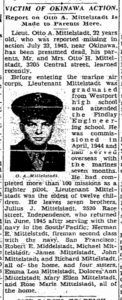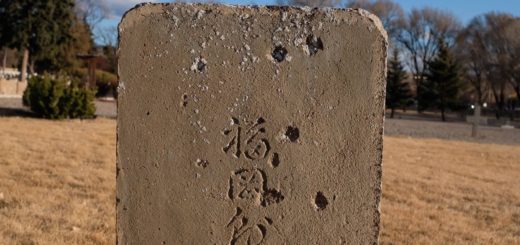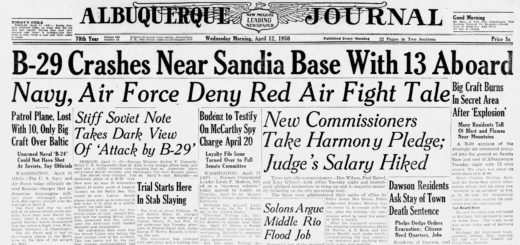Uncle Otto’s Final Mission
23 July 1945.
That is the date my Uncle Otto Anthony Mittelstadt and his plane, a model F4U-4 Corsair only months old, disappeared off the coast of Okinawa just as WWII was coming to a close.
Over the years much of the family lore has been about what happened to him. The legend goes something along the lines that he had flown countless missions leading up to that fateful day and, though tired, he volunteered for one more. I’m not sure where the story originated. Perhaps it was from Navy buddy wanting to comfort the family. Recently, however, the official war diaries of USMC Flying Squadron 223 have become available. They were finally declassified in 2012 and every mission involving every pilot has been accounted for in detail that was unknown before. I found and downloaded the July 1945 diary, and a few from previous months.
Fighting Squadron 223, Aircraft Group Fourteen had 64 pilots at the start of July, 1945. Over the previous months the squadron had been advancing on Japan from further out Pacific islands. As a result, they were flying increased combat missions (as opposed to routine patrols) and involving increasing numbers of planes. At the start of July they were operating out of Awase airfield on the island of Okinawa, itself only captured in April earlier that year. Their patrols and combat missions routinely took them over Japan and over mainland China. Enemy fighting had been fading in previous weeks and months yet as they approached the homeland, a renewed resistance was felt.
Looking at the daily mission briefs, it seems rather routine until about the middle of the month. Missions take on more importance as a massive naval build-up was taking place off the Japanese coast, perhaps for an eventual land-assault. (The atomic bombs dropped at the beginning of the next month obviated the need for that.) The build up required major air cover support.
This account of the missions flown on July 16th shows just how intense the situation was becoming. That squadron had not lost a pilot in quite some time.
16 JULY 1945
A 56 plane fightersweep over Kyushu was ordered by
the Tactical Air Force as Hag 14’s contribution to the days
activities. Twenty-two planes from this Squadron took part
in the operation, with sixteen scheduled for the sweep, and
four to escort the rescue PBM, with two more as replacement
Standbys.Major DEXTER and Its. FINK, OLIVER, HENNESSEY,
SHIRLEY, GOBEL, STAVEN, EVERETT, TIERNAN, GROOT, WALTERS, R.A.
McALISTER, ZORN, LUMLEY, MITTELSTADT and ENGELHARDT joined
with pilots from VMF-212 and VMF-222 in the sweep. When low
lying clouds prevented their sweeping inland, the flight at-
tacked shipping in the harbors at Aburatsu and Tonoura. Lts.
TIERNAN, GROOT, ZORN, and LUMLEY turned back early because of
engine trouble. Lts. SHIRLEY, GOBEL, WALTERS and R.A. Mc-
ALISTER turned back a short time before the attack on the
shipping, when their fuel pressure systems started to function
badly. The remaining eight planes from this Squadron pressed
home their attack, with Major DEXTER leading Lts. FINK, OLIVER,
HENNESSEY, MITTELSTADT and ENGELHARDT against Aburatsu and
Lts. STAVEN and EVERETT hitting Tonoura.Major DEXTER’S sextet strafed 10 to 12 small ships
at Aburatsu, damaging 8 with their accurate shooting. Lts.
STAVEN and EVERETT joined with 3 divisions from VMF-222 in
attacking a group of small ships, including two sailing
vessels 80 to 100 feet long at Tonoura. After the first
strafing run, in which damage was done to at least five ships,
Lt. STAVEN noticed that his wingman, 1stLt. William V. EVERETT,
USMCR(NA), (033367), flying plane #80941, was no longer with
him. Although he made two more runs on the target and searched
the area thoroughly afterward, he discovered no trace of Lt.
EVERETT, nor was he able to get in touch with him by radio.
Shortly after he disappeared, Lt. STAVEN, as well as pilots
of VMF-222 noticed a large fire burning in a group of houses
on the peninsula of Kannon Saki, which forms the northeastern
side of Tonoura harbor. It is probable that the fire was
caused by Lt. EVERETT’S plane having crashed there. However,
no one saw him go in, and he is officially listed as missing
in action as of 1400 I, 16 July, 1945.Captain RADWAY, in the meantime had led Lts. GREEN,
POOR and MORRIS as escort for the rescue PBM, together with
four pilots from VMF-222. Lts. LOVETT and GARRISON took-off
as replacement stand-by and when on of the VMF-222 pilots
had to return early, Lt. LOVETT took his place. The escort
planes had barely reached their station when Captain RADWAY’S
plane (#60875) suffered engine failure, and he made a water
landing in a very rough sea. His position was pinpointed
at 10 miles southwest of Yaku Shima. The time was 1215 I.
The Captain was seen to get out of his plane, inflate his
life raft and climb in. He put out dye marker, which was
picked up readily by the covering pilots and the PBM. The
water was considered too rough by the PBM to attempt a res-
cue, and the life guard submarine was contacted. At 1725 I
Captain RADWAY was finally rescued by the submarine, appar-
ently in fair condition. Lts. POOR, GREEN, MORRIS and LOVETT
were in the air for eight and a quarter hours, during five
of which, they covered Captain RADWAY.Major MORRISON and Lts. HORN, HALEY, ROBERTS, WOZNIAK,
GARRISON, WESTON and KEMP were airborne late in the afternoon,
with the mission of relieving the pilots covering Captain
RADWAY. However, they had not progressed far when they re-
ceived word that Captain RADWAY had been picked up, and they
Returned to base.Lt. MITTELSTADT test hopped a plane.
Providing air cover was the major task of the Squadron for the next several days until on 19 July 1945 they were grounded due to bad weather.
On 20 July only two 4-plane patrols managed to fly, again due to weather conditions. (Flying on that day were Lts. PROULX, OLIVER, HENNESSEY, GREEN, POOR and MORRIS.)
There were three 4-plane combat patrols, and a single two-plane radar picket patrol flown on 21 July, daytime-only. The combat patrols managed to damage two ships in Funsuke harbor and three homes on the nearby island. Portions of the towns of Funauke and Heyemi, and the island of Shimiaji were strifed as well. (Otto Mittelstadt did not fly this day.)
A massive push lead by a Navy Cruiser up the coast of China on July 22 required 20 planes from the Squadron in two sets (8 ad 12). The pilots had to travel more than 300 miles to join the task force which required total flying times of more than 6-1/2 hours. The second set of pilots did not return until well after dark and all made it back without incident.
Otto Mittelstadt did not partake in this mission.
Finally, on 23 July, 1945 we see Otto Mittelstadt take to the air again after 6 days of rest.
23 JULY 1945
Six combat air patrols were flown during the day, led
by Majors DEXTER, MORRISON, Captain KOETSCH, and Lts. WOZNIAK,
LOVETT and VAN RY. Five of these were devoid of incident. On
the patrol led by Major DEXTER, however, the weather brought
tragedy to the scene. Major DEXTER and his wingman 2ndLt. Otto A.
MITTELSTADT, USMCR(NA), (036715), and Lts. Oliver and HENNESSEY
were flying their patrol at dusk twenty miles north of the north-
ern tip of Okinawa. While heading in an easterly direction,
Major DEXTER encountered a local storm which seemed to offer no
difficulty. When the division entered the clouds and flew on
instruments, Major DEXTER immediately turned and flew to the
northwest, getting clear of the storm in a few minutes. Lt.
MITTELSTADT did not emerge from the clouds, and after Lts. OLIVER
and HENNESSEY had joined up with Major DEXTER they searched the
area thoroughly until darkness. They found no trace of Lt. MITTEL-
STADT or his plane (#80920) other than an oil slick and small
pieces of wreckage which were revealed when the storm had passed
from the area. All subsequent searches were negative and Lt.
MITTELSTADT is listed as Missing in Action.Lt. MORRIS test-hopped a plane during the day.
That is it. No combat, just the start of a normal patrol when the planes headed into a storm and Uncle Otto failed to emerge. To this day, no one knows what happened. The site of the wreckage was never searched, to my knowledge.



Recent Comments